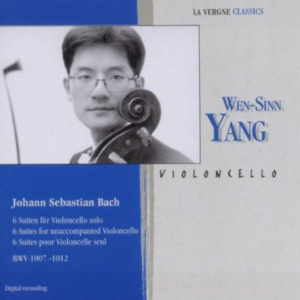
Wen-Sinn Yang. Bach Cello Suites. La Vergne Classics. CD LaVer 100252/53.
Date of release 1997.
Recorded Munich GLS Tonstudios September 1997
Cello played by Matteo Gofriller on loan from the Swiss Maggini Foundation.
The Cellist.
Yang was born of Taiwanese parents in Berne Switzerland. After participating in masterclasses with Janos Starker and David Geringas, he took up the principal cellist position in the Bavarian Radio Symphony orchestra age 24 years.
Other achievements include first prize at the Geneva International Music competition in 1991 and favourable comparison with Rostropovich by a critic of his performance of Schostakovich’s first cello concerto.
All of the above information and more is within the booklet supplied. I do find the writing very challenging mainly due to a strange system for identifying quotes and the use of very long sentences!
The recording.
This is a good quality recording without too much unwanted noise from the player. The acoustic appears to have the right balance between dry and excessive reverberation. Yang’s Gofriller seems to have quite a gruff sound certainly in the lower registers, but a lovely clear sound in the upper regions.
The music.
Starting at the beginning I have to say I feel some disappointment. Both Suites one and two are taken quite slowly. Yang uses a lot of legato bowing with articulation reserved for the Courantes and Gigues in general. The combination of gruff sounding cello, slow pace and legato bowing makes for a rather uninspiring listen! Lack of dynamics and obvious phrasing adds to the negative impressions. However, redemption is around the corner with a much more interesting sixth suite. This slots in to the first CD as is common to even up the time totals for each disc.
The sixth Suite demonstrates the cellist’s technique with which I can find little fault. He never seems stressed and even in some of the tricky high passages seems able to effortlessly phrase and bring into play impressive dynamics. As previously mentioned, the higher passages demonstrate a very pure sweet tone. The phrasing of the sixth Suite was subtle but maintained momentum. The ornamentation in general adds to the enjoyment. In this Suite and generally, Yang uses ornamentation to make the repeated sections contrast and more interesting.
The second CD.
For Suites three to five the promise of the sixth Suite is upheld with elegant phrasing, unobtrusive ornamentation, excellent technique and very reasonable pacing. I find the fourth Suite Prelude particularly enjoyable. This is one that performers tend to play very slowly or very fast. Yang seems to have found the sweet spot for me at least!
Yang approaches the third Prelude with a fair amount of drive still employing a lot of legato but the mid cross string section impresses with even notes and exciting dynamics
The third Sarabande deserves special mention for its most interesting modulations at the end. These I find very pleasing and unexpected but welcome. A good demonstration how a subtle variation can make a big difference. There are a few other areas where this device is used and none where it is liable to cause offence.
Conclusion.
I did go back to Suites one and two to check that I wasn’t particularly jaded when I started listening! They still sounded rather bland. However, the rewards of the remaining performances would lead me to encourage audition of this recording. I suspect Yang’s technique and tone suits more romantic pieces and more modern music. Having said that, I do feel he has produced a worthwhile recording here.
Charles.